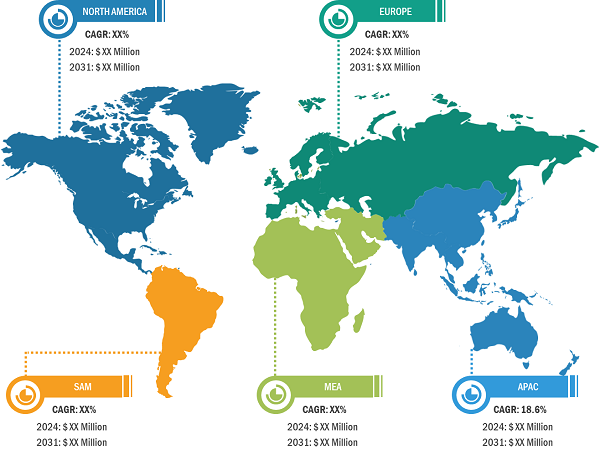Increasing 5G Network Rollout To Fuel The Optical Transceiver Market Growth
According to our latest study, "Optical Transceiver Market Size and Forecast (2021–2031), Global and Regional Share, Trend, and Growth Opportunity Analysis – By Form Factor, Wavelength, Data Rate, Application, and Geography," the market was valued at US$ 14.60 billion in 2024 and is projected to reach US$ 36.73 billion by 2031; it is expected to register a CAGR of 14.2% during 2025–2031. The report includes growth prospects owing to the current optical transceiver market trends and their foreseeable impact during the forecast period.
The global rollout of 5G networks is accelerating rapidly, transforming telecommunications infrastructure worldwide. According to the GSM Association (GSMA), 5G connections reached ~1.6?billion by the end of 2023, and are projected to grow to 5.5?billion by 2030, with coverage expanding in major markets such as the United States, China, South Korea, and parts of Europe. According to the State Council of China, 5G mobile subscribers in China had reached 851 million as of February 2024. Leading telecom operators such as Verizon, China Mobile, and Vodafone are investing heavily in expanding 5G coverage to meet increasing consumer demand for faster, low-latency connectivity. This surge is driven by applications including enhanced mobile broadband, massive IoT deployments, and ultra-reliable low-latency communications, which require robust, high-capacity network backbones to function effectively.
Optical Transceiver Market Analysis — by Geography
Optical Transceiver Market Size and Forecasts (2021 - 2031), Global and Regional Share, Trends, and Growth Opportunity Analysis Report Coverage:by Form Factor (SFF & SFP, SFP+ & SFP28, QSFP, QSFP+, QSFP14 & QSFP28, CFP, CFP2 & CFP4, XFP, CXP, and Others); Wavelength (850 nm Band, 1310 nm Band, 1550 nm Band, and Others); and End-User (Data Center, Telecommunication, Enterprise, and Others), and Geography (North America, Europe, Asia Pacific, and South and Central America)
Optical Transceiver Market 2031 | Size, Share, Growth Analysis
Download Free Sample
Source: The Insight Partners Analysis
The deployment of 5G technology creates significant demand for optical transceivers, as these devices form the critical interface for high-speed data transmission across fiber-optic networks. Unlike previous generations, 5G networks demand much greater bandwidth and lower latency, placing pressure on network infrastructure to scale capacity and speed. Optical transceivers enable rapid data transfer between base stations, aggregation points, and core networks, ensuring that the increased data generated by 5G devices can be transported efficiently. Furthermore, 5G’s dense network architecture featuring numerous small cells requires extensive fiber-optic connections, each relying on optical transceivers for signal conversion and transmission. The inherent requirements of 5G for higher bandwidth, lower latency, and more extensive fiber deployment increase the demand for advanced optical transceiver modules. Thus, the rapid expansion of 5G networks globally is a major catalyst for the growth of the optical transceiver market.
Coherent Corp, Lumentum Holdings Inc, Broadcom Inc, Sumitomo Electric Industries Ltd, Cisco Systems Inc, Intel Corp (US), Amphenol Corporation, Accelink Technology Co Ltd, NEC Corp and Samtec Inc (US) are among the key players profiled in the optical transceiver market report. Other major players were also studied and analyzed in the market study to get a holistic view of the market and its ecosystem.
The report includes the optical transceiver market forecast by form factor, wavelength, data rate, and application. Based on form factor, the optical transceiver market is segmented into SFP Series, QSFP Series, CFP Series, and others. In terms of revenue, the SFP Series segment held the largest optical transceiver market share, and the QSFP Series segment is expected to register the highest CAGR during the forecast period.
The scope of the optical transceiver market report focuses on North America (the US, Canada, and Mexico), Europe (Spain, the UK, Germany, France, Italy, and the Rest of Europe), Asia Pacific (South Korea, China, India, Japan, Australia, and the Rest of Asia Pacific), the Middle East & Africa (South Africa, Saudi Arabia, the UAE, and the Rest of Middle East & Africa), and South & Central America (Brazil, Argentina, and the Rest of South & Central America). North America dominated the market in 2023, followed by Europe and APAC.
The market in Asia Pacific is segmented into Australia, China, Japan, India, South Korea, and the Rest of APAC. In terms of revenue, China held the largest optical transceiver market share in APAC due to its aggressive 5G deployment, smart city initiatives, and expanding cloud data centers. Major Chinese tech firms such as Huawei, ZTE, Alibaba, Tencent, and Baidu heavily invest in high-speed networking infrastructure, necessitating advanced optical transceivers. Government policies supporting digital transformation and domestic semiconductor self-sufficiency boost local transceiver production and adoption. Furthermore, the country’s Belt and Road Initiative includes laying international fiber-optic cables, enhancing cross-border demand. China’s push toward artificial intelligence (AI), Internet of Things (IoT), and autonomous systems requires low-latency, high-bandwidth networks, for which optical transceivers are critical. With a strong manufacturing base and strategic research and development, China not only meets domestic needs but is also a major exporter in the global optical transceiver market
Contact Us
Phone: +1-646-491-9876
Email Id: sales@theinsightpartners.com